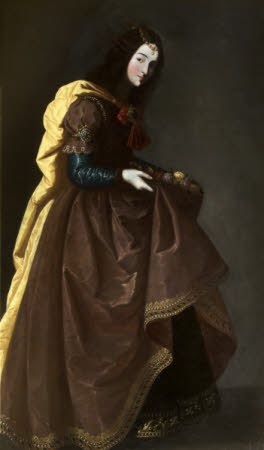Saint Elizabeth of Portugal (1271-1336)
studio of Francisco de Zurbarán (Fuente de Cantos 1598 - Madrid 1664)
Category
Art / Oil paintings
Date
1630 - 1650
Materials
Oil on canvas
Measurements
1816 x 1067 mm (71 1/2 x 42 in)
Order this imageCollection
Kingston Lacy Estate, Dorset
NT 1257135
Caption
This is a similar example from the sets of female saints produced by Zurbaran and his studio in Seville in the 1630s. Here she is sumptuously dressed with flowers gathered in the ample folds of her dress. Her emblem is usually the rose, based on a legend that when her brutal husband, one winter, challenged her with wasting her money on the poor, the scraps of food miraculously turned to roses. Elizabeth, daughter of Pedro III of Spain, and named after her great-aunt Elizabeth of Hungary (1207-1231), married King Denis of Portugal (1261-1325) at the age of twelve. She was pious, generous and concerned with the welfare of her people. On the death of her husband she went on a pilgrimage to Compostela, became a Franciscan tertiary and retired to Coimbra where she spent the remainder of her life near the Poor Clare convent which she had founded. She also is invoked in time of war. When, in 1336, her son, King Alphonso IV of Portugal (1291-1357) led his troops against Alphonso XI of Castile (1311-1350), she went onto the battlefield itself to reconcile them. Her feast day is the 4th July, the day of her death. She was canonised by Pope Urban VIII (1568-1644) in 1626, just before this picture was painted. It was bought to replace the Velazquez portrait of Philip IV, sold to Isabella Stewart Gardner in 1896, and cut down to adapt to its new location.
Summary
Oil painting on canvas, Saint Elizabeth of Portugal (1271-1336), studio of Francisco de Zurbaran (Fuente de Cantos 1598 - Madrid 1664), 1630-50. A full-length, walking to the right her head turned three-quarters to spectator her eyes looking directing at spectator, dressed in sumptuous clothes, composed of a brown dress, heavily trimmed with pearls and embroidery at the sleeves and hem and a yellow cloak thrown back from her shoulder; she also wears a jewelled circlet her head and forehead. She is holding flowers in the ample folds of her dress which she holds up in front of her. Bought to replace the Velazquez portrait of Philip IV, sold to Isabella Stewart Gardner in 1896. Named after her grand-aunt Elizabeth of Hungary (1207-1231), daughter of Pedro III of Spain (1239-1285), she married King Denis of Portugal (1261-1325). As queen she was known for her piety, generosity and social concern for the welfare of the people. Her marriage, which was unhappy produced two children, one of whom succeeded as King Alphonso IV of Portugal (1291-1357). On the death of her husband she went on a pilgrimage to Compostela, became a Franciscan tertiary and retired to Coimbra where she spent the remainder of her life near the Poor Clare convent which she had founded. In the year of her death her son Alphonso IV led his troops against Alphonso XI of Castile (1311-1350). Elizabeth went onto the battlefield itself and reconciled them, thus averting the usual bloodbath which would have ensued. She died on the 4th July at Esteremoz and her body was taken for burial at Coimbra. Miracles were associated with her tomb and she was canonised by Pope Urban VIII (1568-1644). Her emblem in art is the rose, either worn in a crown or carried in wintertime, which was based on a legend that when her brutal husband challenged her with wasting her substance on the poor the scraps of food gathered in her dress miraculously turned to roses. Her feast day is 4th July and she is invoked in time of war.
Provenance
Bought to replace the Velazquez portrait of Philip IV; first recorded in 1905; bequeathed by Ralph Bankes, 1981
Credit line
Kingston Lacy, The Bankes Collection (National Trust)
Makers and roles
studio of Francisco de Zurbarán (Fuente de Cantos 1598 - Madrid 1664), artist

